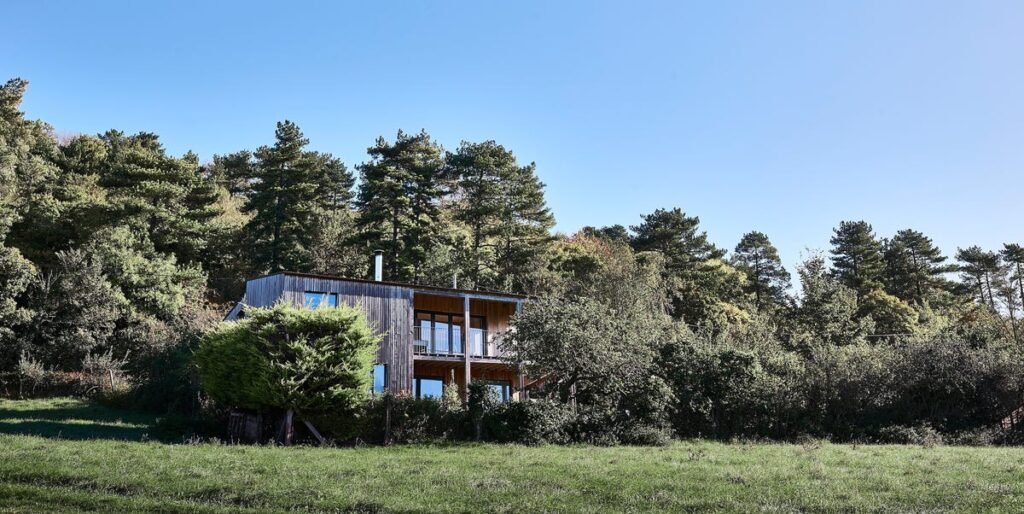As an architect and an interior designer, Graham and Emily Bizley had all the skills necessary to renovate the rundown house they found on a wooded hill in Somerset. Tucked away down a quiet lane, this self-designed house looks both entirely at home and somehow rather extraordinary in its country surrounds, as though it’s been transplanted here from Scandinavia.
With its weathered oak-clad exterior and wide-span roof, it’s the kind of property that’s commonly found in northern Europe but rarely in the UK. ‘We wanted a bolthole that suited our personalities and made the most of the sweeping views,’ explains Emily. ‘The whole point of having a blank canvas is that you can create something stunning,’ she says.
In fact, this is an even more unusual building than it seems at first glance, having been constructed using the principles of the Passivhaus building standard developed in the 1990s to build homes that are eco-friendly and energy-efficient. ‘It’s a system that combines advanced insulation, clever heat-exchange technology and careful orientation to avoid the need for heating the house, even in the depths of a British winter,’ explains Graham.
Emily and Graham bought the quarter-acre plot in 2010, with a neglected 1920s bungalow in situ. ‘It was a sorry looking thing, largely made from asbestos and bits of string,’ he laughs. The project was funded by the sale of a house Graham had built in Newington Green, north London. Work began on the site in January 2012 and the exterior was completed the following winter.
Built into the steep lower slopes of a thickly wooded hill, 100 metres from the Somerset Levels, the house is more than twice the size of the bungalow that once stood in its place. Despite now being two storeys tall, the roofline is only slightly higher than its predecessor, which was achieved by digging the lower level down into the heavy clay soil of the slope.
The layout itself is practical as well as aesthetically pleasing, oriented so that its widest, highest aspect faces south west and south east to catch the warmth of the sun, while the back of the house, facing north east, has been built into the ground to minimise heat loss. With this aspect also facing the road, the low and almost windowless facade provides the property with a secluded and private spot while wide overhanging eaves shelter a wood store and parking space. Concealed from sight, only opening up on the other side of the building, is the breathtaking outlook that spans the Somerset countryside.
With energy efficiency at the forefront of this design, it’s no surprise that these eco credentials continue within the property. The front door provides insulation and, along with the triple-glazed windows in their deep frames, gives a feeling of solidity and quality. A small oak-clad entrance hall greets visitors, its roughly slatted ceiling intentionally low. And from here, just within the confines of the house, there is a glimpse of the view that gives this property its wow factor. As Emily says: ‘People always crane their necks to see it.’
The main bedrooms are located on this upper floor, along with a spare bedroom and bathroom. The kitchen, with its high, sloping ceiling and huge windows, is the largest space in the house, clearly designed with family and entertaining in mind. Clad in French oak planks, it’s furnished with a freestanding work bench and a mix of mid-century Danish chairs. The simple kitchen table – made by Graham from Ikea trestles and a few floorboards salvaged from the old bungalow – ties the room together.
This magnificent space leads out onto the balcony, which wraps around two sides of the house and is sheltered by the overhanging roof. ‘Our children Flora and Arlo love running around on the balcony, as do their friends when they come over,’ smiles Emily. ‘We adore coming here. You can feel yourself relaxing on the drive down,’ she says. ‘We’ve made friends in the area, and so have the children. It’s the perfect antidote to London life – it’s just so peaceful.’
To find out more about Graham’s architecture firm, visit prewettbizley.com and for Emily’s interiors, studiobizley.co.uk










